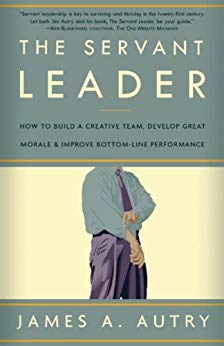This book, “The Servant Leader: How to Build a Creative Team, Develop Great Morale, and Improve Bottom-line Performance,” by James A. Autry, is very much a how-to book, describing the way to implement servant leadership in many aspects of leading an organization. James Autry was president of the magazine group for Meredith Corporation and later a business consultant and speaker.
The author begins with a list of five attributes that describe servant leadership. A servant leader must –
- Be Authentic – be real or be who you are in every situation. This includes the concept of honesty and integrity, not fudging or giving yourself some wiggle room around the truth.
- Be Vulnerable – being honest with your feelings in the context of your work, being open with your doubts and concerns about an idea, and being able to own and admit your mistakes.
- Be Accepting – assigning value to and accepting every person around you regardless of style or personality. This doesn’t require accepting every idea or never disagreeing, but refers to accepting of the person.
- Be Present – be fully available and attentive in human interactions. Be centered rather than distracted or attempting to multitask.
- Be Useful – in other words, be a servant. Be a resource for your people, helping them to be productive and successful.

With this foundation defining servant leadership, the rest of the book applies these traits to the daily practice of leadership. An overarching principle of the book is that servant leaders guide their team or organization to also practice servant leadership principles. Therefore, the team members, following the example of the leader, serve each other.
The book is divided into four parts, with the first devoted to describing servant leadership as noted above. The second part describes how servant leadership shows up in the daily activities of the leader such as hiring people that will fit with the culture of servant leadership, building servant leadership practices into the organization, and managing performance through job descriptions, performance standards, and performance appraissals in a way consistent with the principles.
The third part of the book suggests methods consistent with servant leadership principles in dealing with issues that arise in leadership. This includes dealing with organizational issues such as firing people, closing or relocating operations, or re-focusing a business; personal issues such as dealing with illnesses, either of employees or within their families; or legal issues such as lawsuits and harassment.
The fourth part of the book deals with the circumstances in which servant leadership can be put to the greatest test such as during economic or market downturns, in dealing with the balance between work and family, and dealing with conflict. In discussing conflict the author presents a number of tools for identifying, preventing, and encouraging resolution of conflict.
The servant leader is a steward of both the organization and the people within the organization. As such, he/she is frequently in the position of weighing the interests of various parties versus policies and practices of the organization. The author makes the point that dealing positively with people is most often the best choice for the long-term health of the organization. A servant leader leads in such a way as to build community of service within the organization that leads to a healthy and productive team.
This is a good book on the subject of servant leadership with lots of practical advice and examples of application.

Add your comment